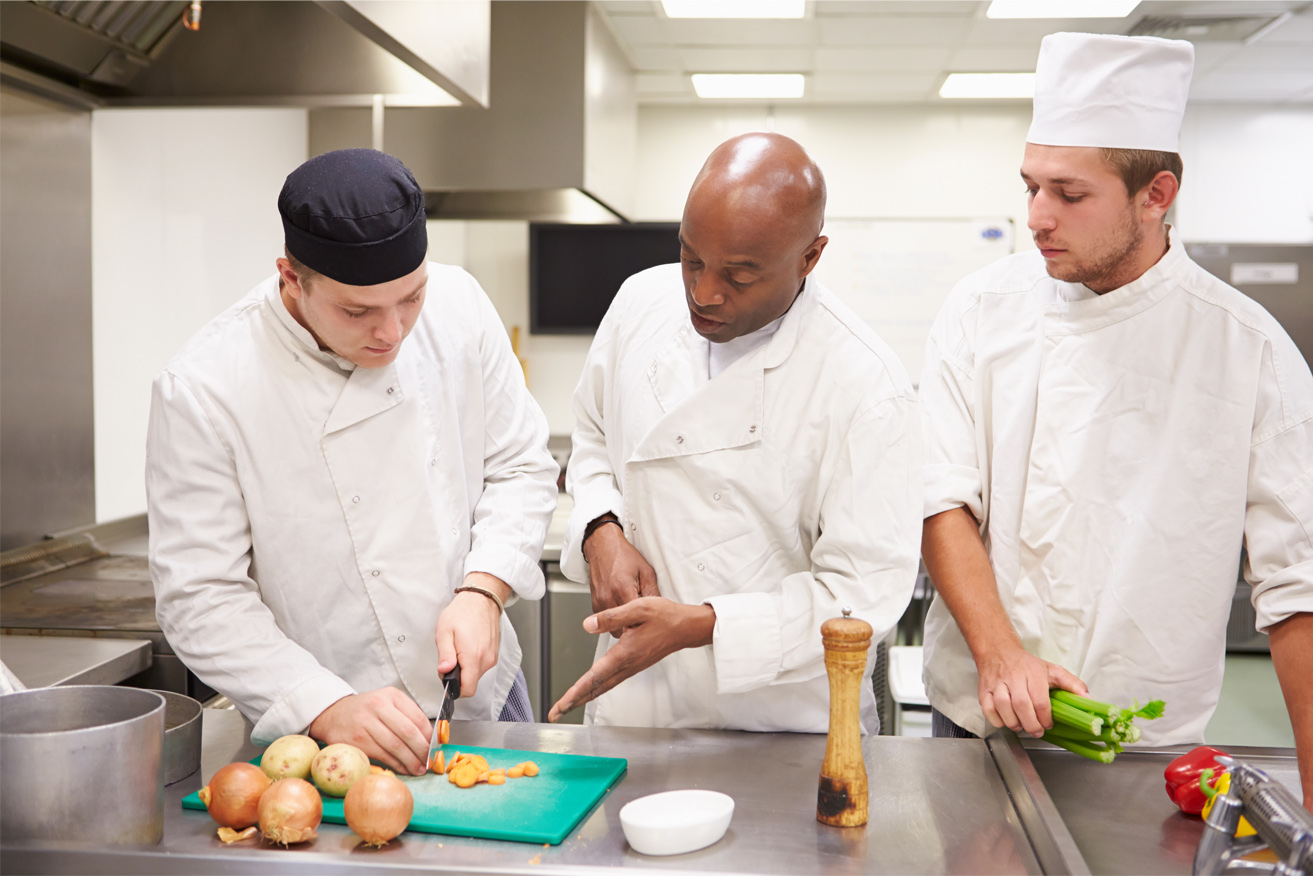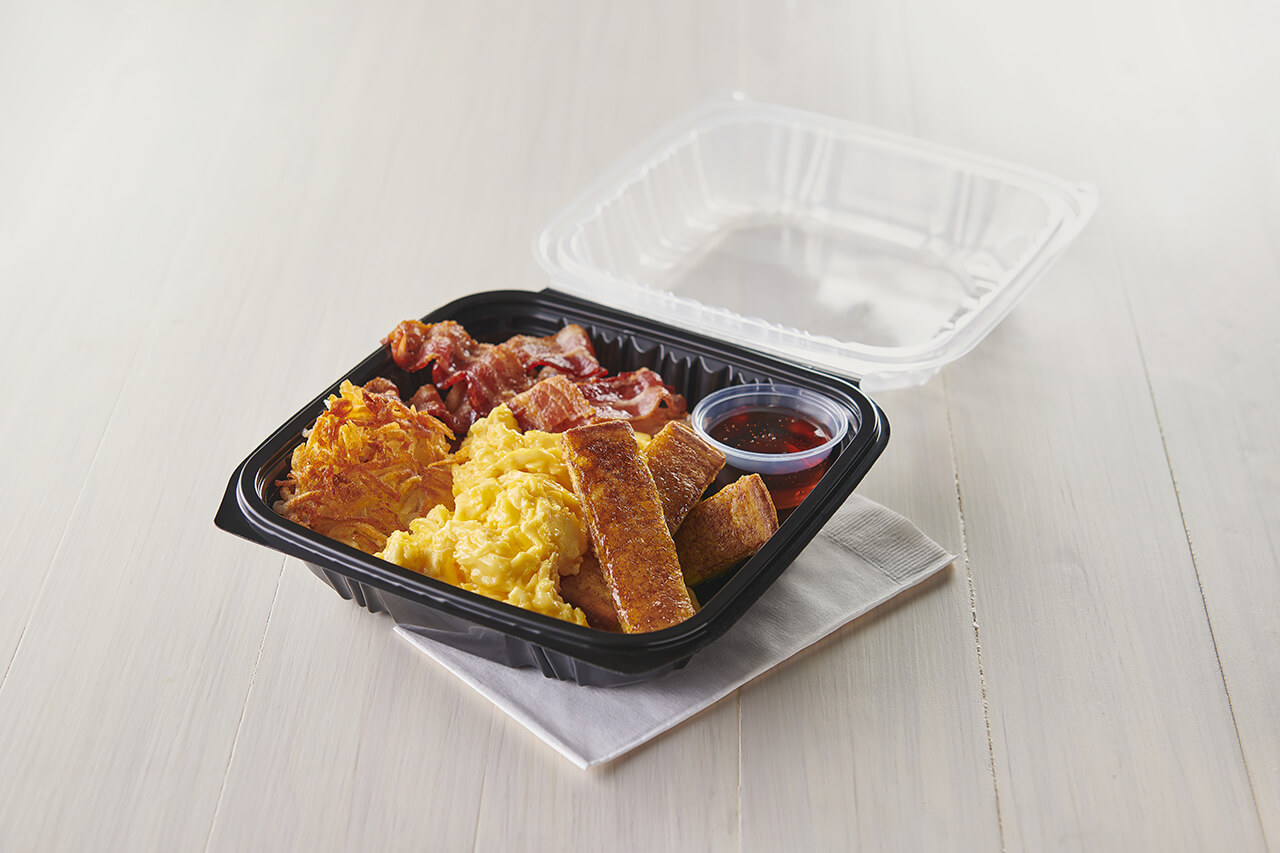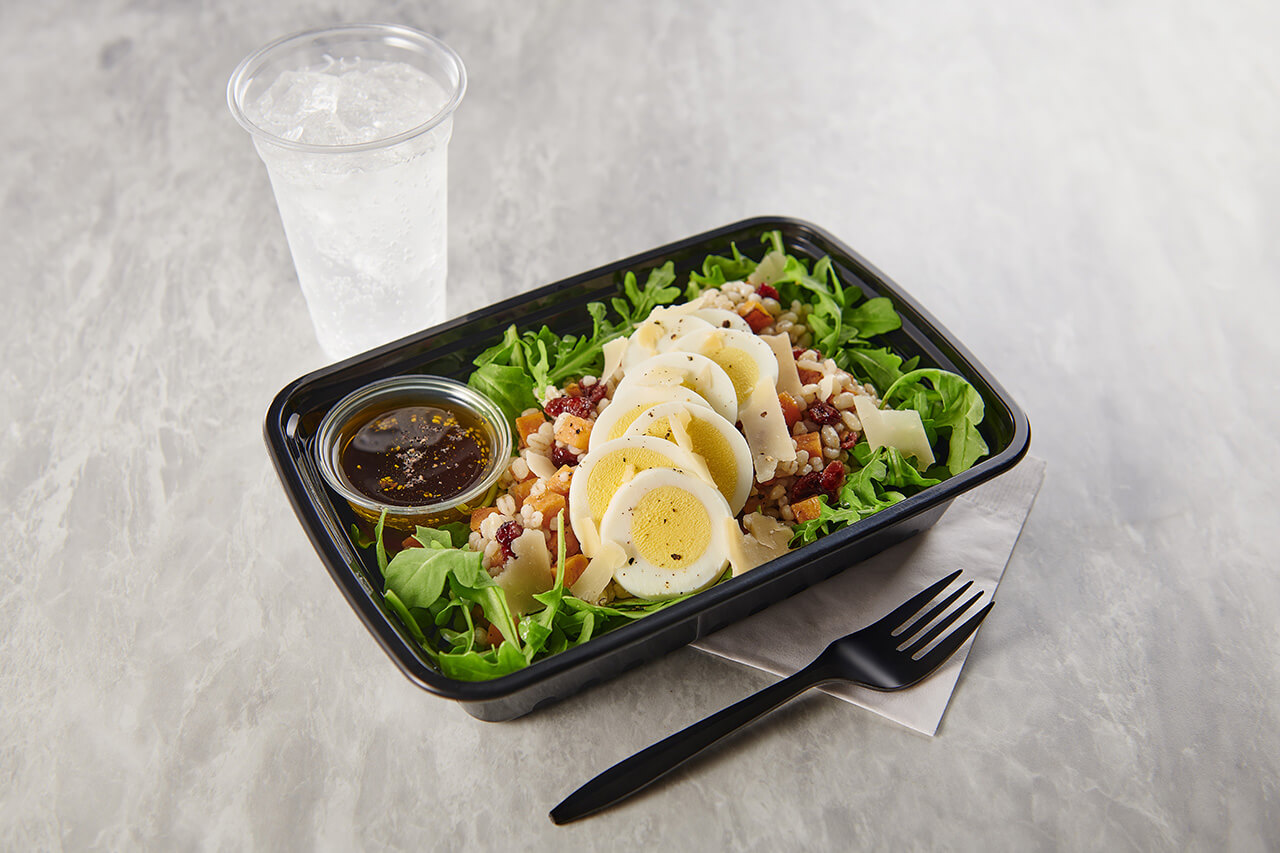Disclosure
Commercial support for this program has been provided by Michael Foods.
Looking to sign up for our newsletter? Click here
Sign up for NewsletterSauces & Dressings
Baked Goods
Pastas
Sports Nutrition
Pet Foods
Learn about our team’s extensive capabilities and resources.
Get to Know UsEggs
Potatoes
French Toast
See the Story From Our Farm To Your Table

Michael Foods Online CE Course (1 hour CE)
Michael Foods, Inc. will maintain verification of your attendance. Please fill out the following information. Upon completion of this course, a certificate of completion will be available for download.
Commercial support for this program has been provided by Michael Foods.

“Labor, particularly attracting and retaining labor, has been a pressing challenge in the foodservice industry for quite some time,” remarks Estrada (Feb. 14, 2024). The high cost of labor, along with major shifts in service models since the pandemic, has foodservice operators everywhere looking for new solutions to meet labor requirements. “The pandemic fundamentally changed what, how, and where consumers eat,” claims Food Management (2022).
Changes were fast-paced and fundamental to foodservice operations, comments Mondelez (2021). “Some of these quick-adapts have forever changed foodservice,” they remark. There’s been a drop in high-end dining and a trend towards fast-casual, grab’n’go, convenience, automated service points, and delivery, Food Management points out. With these service model shifts, they say, “Labor usage will evolve.”
McKinsey (July 26, 2023) explains that the pandemic triggered major changes in the workforce. “During the pandemic (2019–22), the US labor market saw 8.6 million occupational shifts,” they say. Foodservice, along with customer service and sales, were the two industries that workers most often left, they report. Office support and production work also saw declines. This means that many people who worked in foodservice prior to the pandemic have now pursued alternate career paths. “Demand for lower-wage service work remains, but fewer workers are accepting these roles,” they explain—which sets the stage for continuing labor shortages in foodservice.
Labor costs have been rising as well, compounding operational pressures on foodservice establishments. The 2024 State of the Restaurant Industry from the National Restaurant Association reports that 98% of operators cite higher labor costs as an issue.
Reinventing use of labor is driven by constrictions in the labor market, as well as the cost-pressure imposed by rising food prices. Lower costs help operators maintain profitability, and operators are seeking ways to do more with less.
This course examines labor issues and related service changes in the industry. It presents solutions built around menu tweaks and inventory choices, with a focus on how to evaluate convenience products and apply speed-scratch production techniques to minimize labor and maximize profits.

Upon completion of this course, participants will be able to:

One in 10 U.S. workers is employed in the foodservice industry, according to the National Restaurant Association (Feb. 4, 2024), and more than one-quarter of operators say that “recruiting and retaining employees will be the most significant challenge to meet,” they report. Nearly half of operators say they need more employees to meet customer demand.
A shortage of foodservice workers has been a defining force for the industry. “The rebuilding of the restaurant and foodservice workforce is being hampered by the most severe labor shortage on record,” remarks the National Restaurant Association (May 6, 2022),
Following pandemic-related shutdowns, many industries are “working their way back to normal staffing levels,” the National Restaurant Association said in Aug. 2022, but foodservice was lagging far behind, with employment still 635,000 workers below pre-pandemic levels. As of January 2024, though, the National Restaurant Association reported that employment in foodservice had returned to pre-pandemic levels (accessed Feb. 26, 2024). The character of employment needs has changed since the pandemic, with a sharp decline in full-service dining and increases in quick service, fast casual, snack venues, and others, they note.
Labor shortages are not new to the industry, comment Clark and Danieli (2022). High turnover and open positions have been a perennial challenge. Feeling undervalued and “lacking incentives for hard work,” they say, have been employee pain points for a long time.
Datassential (2022) reports that labor concerns represent two of foodservice operators’ top five operational challenges:
Today, operators “have a chance to reinvent themselves as progressive employers who cultivate quality of life for their employees,” suggest Clark and Danieli. They can focus on a positive work culture and flexibility to increase the appeal. Higher wages for top-performers, bonuses for employment referrals, and phased-in rewards that keep employees feeling invested are all tactics they recommend. They also suggest surveying employees to keep a pulse on ongoing job satisfaction. These are not temporary solutions, in their view: “The current labor landscape isn’t a blip but the beginning of a long-term shift to an employees’ (rather than employers’) market.”
Datassential (2022) found that in Fall 2022, 30% of foodservice operators in all segments ranked labor as an economic challenge—almost as high as they ranked food inflation (38%). They said, “The labor shortage is most acute in the kitchen.” Hourly cook positions—line cooks, prep cooks, and other back-of-the-house position—were hardest to fill, according to operators. One in three operators also said they’re seeing a drop in culinary skill levels in their kitchens. “Locations lacking experience, or the time and resources to train new cooks, likely will need to explore value-added or convenient products that reduce the need for scratch cooking,” commented Datassential.

The foodservice industry “has been through the ringer on labor throughout the past few years,” according to Kelso (May 24, 2023). She cites an “all-time high quit rate,” along with union organizing, retirements, and more. The employee turnover rate for the industry, she says, is twice the national average; people do not seem to want to stay in foodservice jobs.
Turnover can leave positions open and add significant costs to a foodservice operation. Sometimes, low levels of job satisfaction contributing to turnover can set off a vicious cycle. If employees leave and staffing is inadequate, the stress on remaining employees grows. This can lead to further turnover. According to Peters (Nov. 13, 2023), the cost of foodservice employee turnover is estimated at $4,129 per person. Consider the costs of recruitment, orientation and training, and reduced efficiency for a new hire.
One solution to this problem is investing in employee culture, suggests Kelso. Employees will not stay if the workplace environment is not positive. According to an expert she interviewed, Anthony Lambatos, “Workers now want to be doing jobs where they feel they have a purpose” and jobs that “add value and with people they love, trust and respect.” Lambatos emphasizes taking care of employees because that motivates them to take care of customers.
Peters (Nov. 13, 2023) agrees, saying common reasons employees leave are a poor work environment, limited opportunities for advancement, and poor communications.
A key strategy in employee retention is training, adds Kelso. Another expert she interviewed, Rebecca Beery, called training “the biggest opportunity” for solving the problem of turnover. Her stats: 87% of Millennials say training is critical to their job, and more than nine out of 10 employees say they want a company to invest in their careers, which would incentivize them to stay.
Training can help employees succeed while also building a career path. At the same time, it can elevate customer service. Certification and online training are some of the options Kelso cites. As an example, the National Restaurant Association (2024) offers a variety of programs and certifications for foodservice workers, including the well-known ServSafe series and the FMP credential.
In specific industry segments, there are additional professional development and credentialing options, such as the CDM, CFPP credential from the Association of Nutrition & Foodservice Professionals, the Certificate in School Nutrition and the School Nutrition Specialist credential from the School Nutrition Association, and multiple options for chef certification from the American Culinary Federation. Each of these can require significant investments, while often transforming an entry-level job into a career path.
Echoing concerns found in many segments, labor was highlighted in a recent report from the National Association of College and Universities Foodservice called 2030 and Beyond (Estrada, Feb. 14, 2024), which cites solutions such as adoption of technology, building culture, and trying new strategies for appealing to student labor. According to the report, students are attracted not only to fair pay, but to benefits and professional development. Juggling busy schedules, some may also prefer “microshifts,” which are very short shifts (two hours) they can fit into their schedules.

On-the-job, inservice training builds culture and a sense of purpose. Explains Pepitone (June 7, 2021), “Building a robust training schedule can not only make the operation run more smoothly, but also teach staffers skills that will benefit them for life in any field.” She advocates having conversations with workers about their interests and challenges. In her examples, topics such as having difficult conversations with customers and building leadership skills were well received. She also emphasizes keeping training hands-on and collaborative.
Topics for on-the-job training are also limitless and can align with needs observed. Rivera (Jan. 23, 2022) offers a list of ideas: food safety, bussing, serving food, cleaning and sanitation, customer service, opening and closing the restaurant, food handling and storage, cashiering, effective communication, workplace safety, knife handling and safety, and first aid.

Cross-training employees is a time-honored strategy for improving productivity, sometimes doing more with less. It provides flexibility in staffing roles. In addition, if accompanied by adequate training, it can give employees the satisfaction of learning additional skills. Kalloch et al. (Sept. 22, 2023) call cross-training a “powerful tool for improving operations, as well as for attracting and retaining workers”. Having a team of cross-trained employees can help a foodservice operation deal with variable demand as well, they point out. Research in human resources management has demonstrated that cross-training can be a powerful motivator, they add.
“Employees don’t have to be cross-trained to do everything, but a little bit of cross-training can go a long way,” they advise. Foodservice managers can identify “bottleneck tasks” and focus on these for cross-training. Examples are assigning kitchen staff to bring out food to customers or assigning front-of-the-house staff to restock serving areas from the kitchen or to help with prep during slower service times (depending on how existing job roles are defined). Dishwashing is another task that can be shared, they note.
Cross-training can enhance a sense of ownership of success and promote teamwork, the authors say. By getting a taste of other roles, employees may also demonstrate their talent and/or interest in new roles in the operation.
Risks of cross-training are simply overloading employees or reducing the quality of work, according to Kalloch et al. To overcome this, a foodservice manager can simplify operations, set clear standards, empower employees to make judgments, and allot adequate time for training on new tasks. “A better system can drive operational excellence and let teams live up to their potential,” they conclude.

Devotion to off-premise service models, such as take-out, delivery, and even take-home meals, grew throughout the pandemic (Food Management, 2022), as offices, schools, and restaurants closed and many foodservice operations ground to a near-halt. While off-premise models were originally intended to prop up sagging revenues, now they are often considered as a way to supplement revenues from on-site sales, notes Food Management.
“The shift to grab’n’go is here to stay,” according to Mondelez (2021)—and in the non-commercial foodservice arena, it’s important for operators to compete with retail venues by leveraging the trend. For healthcare, they recommend promoting prepackaged grab’n’go, still favoring this over the traditional salad bar model. In business and industry foodservice, they recommend highlighting convenience, affordability, and flexibility in menu fare. For school foodservice, they also point to (kid-friendly) grab’n’go as the best strategy.

Salad bars, buffets, and other self-service venues went by the wayside during the pandemic. Now, however, they are slowly returning, reports Food Management (2022). Full dining rooms are nearly back in swing as well.
Meanwhile table-service models are being replaced with counter service and some tech-powered hybrids, explains Food Management. “The shift allows for more kitchen and less front-of-the-house space, along with fewer wait staff, thereby allowing for fewer workers per shift and more room in the back to prep to-go and virtual orders.”

Dining and foodservice areas were regarded as potentially contagious gathering places in the early stages of the COVID pandemic, which fueled growth of service models that reduce or eliminate personal contact.
“Digital tools and applications proved to be huge assets in the early days of the pandemic as they facilitated delivery, aided no- and low-contact interactions, and promoted overall safety,” says Mondelez (2021). Today, they note, “As operators continue to face labor challenges, digital tools that allow greater automation are proving to be even more valuable to operational ease.”
Analysts for Food Management (2022) agree. They point out that automated service points grew in popularity during the pandemic, and now they’re poised to continue for new reasons. In the beginning the focus was on “touchless” foodservice. Now, the driver is scarcity of labor. In addition, automated service points allow operators to provide service over extended hours, such as vending services when a traditional foodservice venue is not open.
Some examples of automation that reduces labor requirements, according to Food Management, are smart fridges, automated retail outlets, high-tech vending, robotic food stations, and pay-at-the-table technology. Robots and drones are emerging technologies for food delivery, they note. Kelso (2022) points to robot servers, such as Rita, the robot server used at Chili’s.
During the pandemic, touchless service took off as many consumers were wary of touching surfaces. Today, they’ve adjusted and continue to prefer touchless options. An example is a beverage dispenser that a consumer operates through a smartphone, says Food Management.
Both operator and consumer acceptance of automated technologies is evident. Mondelez (2021) reports that more than half of foodservice operators “believe automation attracts patrons,” and many also feel that automation “boosts employee morale.” More than two-thirds indicate they intend to increase technology budgets in coming years.

As noted in the 2024 State of the Industry report from the National Restaurant Association (Feb. 4, 2024), “47% of operators think using tech to help with labor challenges will become more common this year.”
Technology is being explored broadly as a resource for reducing labor demands in foodservice. For example, the 2030 and Beyond report from the National Association of College and University Foodservice “urges foodservice leaders to consider the role of robotics in helping labor” (Estrada, Feb. 14, 2024). Discussing robots as a labor solution, Food Management (2022) predicts that mainstream adoption of foodservice robotics is almost here. Among the intriguing concepts are robotic bartenders for festivals and sporting events and robotic food prep in which a robot 3D prints and cooks plant-based burgers, they explain.
For food delivery: Vijay (2022), says delivery robots are bridging a gap. He reports that hotels like Hilton and Marriott are using artificial intelligence (AI) and robots to deliver meals, while meal delivery services like Grub Hub and Uber Eats are also partnering with robotics companies.
“With labor shortages throughout manufacturing, logistics, and virtually every other industry, companies of all sizes are increasingly turning to robotics and automation to stay productive and competitive,” said Jeff Burnstein, president of the Association of Advancing Automation, as quoted in Vijay’s article.
Surveys show that almost three out of four consumers are willing to place a food order when they know it will be delivered by a robot, Vijay adds.
For meal production: Automated meal production robots such as Sally the Salad Robot have become a growing replacement for self-service salad bars. For example, Gingerella (2021) points to implementation of an automated salad robot at Washington University in St. Louis to replace salad bars and address staffing shortages. She also points to self-ordering through mobile platforms as a major area of growth.
FoodService Director (Jun 15, 2022) reports on the success of automated pizza stations in college and university foodservice. Using a just-in-time production model, they can make 100 pizzas per hour after an employee loads the dough. The solution has reduced required staffing of three people down to one, they report. Estrada (Feb. 14, 2024) points to the success of an automated smoothie kiosk in college and university dining.
Robots are also being tested in fast food to fry foods and cut avocadoes, according to Luna (Sept. 14, 2023). An avocado-cutting robot “is expected to slice guacamole preparation time in half,” and a future plan is incorporate AI to reduce waste. AI is already significantly in use in the fast food industry to take orders via drive-through or phones, adds Luna.
Growth of AI: Applications of AI are in their infancy today, but rapid advancements are expected. Besides handling customer orders and communicating in multiple languages, AI is being explored for food and labor forecasting, financial analysis, menu development, and trend analysis, according to Owings (March 10, 2023).

Convenience store sales grew by more than 7% in 2020 and almost 7% again in 2021, reports Nielsen (2022). “The COVID-19 pandemic presented convenience retailers with a perfect opportunity as many shoppers began opting for quick in-and-out trips to the store to limit exposure while also staying closer to their homes,” they explain.
The residual effects today? Convenience is still a powerful driver among consumers, says Nielsen, and the total experience matters. “Innovations in packaging, food and beverage preparation, product portability, easy ordering and payment capabilities, and digital rewards programs are some factors to consider in providing an overall convenient and seamless experience,” they note.
Factors for success: Consumers are also focusing increasing attention on healthy options as they look to convenience foods. The NPD Group (2022) observes, “Wellness now directly impacts 21% of all eating occasions.” Says Nielsen, “To capitalize on this demand, retailers need to expand their snack and beverage offerings to include convenient products with better-for-you on-package claims (keto-friendly, low-fat, low-sodium) for the growing segment of proactive health consumers. For on-the-go shoppers, prepared and ready-to-eat/drink products that provide added convenience (i.e., resealable, single serve), in addition to nutritional benefits will become especially attractive.”
When customers shop convenience, they prioritize price above all, according to Convenience Store News (2022). It’s also important to them that the food they came to purchase is stocked, that there is good variety of choices, and that the experience is designed to be convenient.
Another concept that emerged during the pandemic is micromarts, which are “unattended stores that offer consumers automated cashless payment from self-checkout kiosks,” according to FoodService Director (Jul 21, 2022). As touchless systems, they do not require labor for ongoing service functions, and they keep customers in control of the experience.

“Streamlining” has been the buzzword when it comes to menu planning. The 2024 What’s Hot Culinary Forecast from the National Restaurant Association (2023) names “menu streamlining” one of the top five “macro trends” affecting restaurants today.
The rationale is multifold. “Supply and labor shortages, rising food costs, and new dining preferences prompt operators to streamline menus,” remarks the National Restaurant Association (Feb. 17, 2022). This means “reducing the number of food items on menus, losing the slow sellers, lightening the kitchen labor lift, and monitoring food waste,” among other things, in their assessment. They describe streamlining as a win-win, with menu decisions becoming easier for customers and kitchens becoming more cost-effective.
A smaller menu can reduce the workload on current staff, says Smith (2022). The way to do it: “analyze your menu items to identify the most popular dishes and purge out the slow-moving ones, particularly those that entail multiple cooking steps.”
Gingerella (2021) explains that college and university foodservice operators are reducing menu offerings, choosing to retain only the items for which they can achieve speed of service and high quality standards.
As grab’n’go menu popularity soars, Mondelez (2021) recommends these factors for success:
In school foodservice, Gingerella (2022) points to the success of all-day breakfast, breakfast pizza, overnight oats, breakfast bowls, and smoothies.

The foodservice industry is undergoing a transformation away from scratch-cooking, according to Kelso (2022); it’s too labor-intensive. “Scratch-cooking is something we admire and many operators aspire to, but that takes a lot of people,” she comments.
The goal among operators is to create “the same experience for customers that they had before the pandemic” in the most labor-creative manner possible, she says.
Ease of prep: Ease of preparation is a crucial factor in menu planning and related recipe development. Making shifts in “tactical-level prep” can save labor time and costs, says Kelso (2022). Fresh produce that requires chopping or cutting, for example, can be purchased already washed, cut, and ready-to-use.
Cobe (2021) points to staff reductions gained by paring back the role of a cook who butchers meats on-site and a pastry chef who prepares desserts. Using pre-cut meats and other conveniences can be strategies for reducing the food prep load while sustaining an enticing menu.
In addition, any menu item that requires multiple preparation steps could be a candidate for change, according to Cobe’s findings from interviews with a variety of operators.
Kelso points to a “significant uptick” in use of pre-made foods, too. She says, “Less labor-intensive food items are gaining in popularity,” according to recent foodservice purchasing data. The trend pervades all segments of the foodservice industry, she notes.
Pre-made food products: Pre-made food options from manufacturers are a strong match to foodservice operational needs today, Kelso points out. In the past, they may have been optional for operators who could fill the need with prep workers, but today, that choice is largely disappearing. Kelso points to the likelihood that this shift will remain, even if the labor market eases.
An analyst Kelso quotes from Buyers Edge Platform, which analyzes foodservice data, says that operators are starting to look at these choices more realistically. She also tackles the operator perception that choosing pre-made food products is a compromise in terms of menu quality. She points to the high quality of pre-made products available today, which are “well thought-out” and creative.
Datassential (2022), acknowledging the back-of-the-house “skill shortage” faced by operators, suggests that there is both a labor shortage and a growing need to adopt convenience products in foodservice, reducing the need for food preparation staffing. This recommendation applies to all segments, including QSR, fast casual, healthcare, business and industry, K12 school foodservice—and most of all, to college and university (C&U) dining, they suggest. This is because C&U has faced the largest drop in skill sets, according to their research. 17% of operators they surveyed indicated they plan to “transition to more pre-made products”.
“The migration toward frozen and prepared foods is unsurprising,” says Datassential. They added that some operators have shifted more toward frozen products, and some are adopting fully prepared products. More than one-quarter of operators indicated an intent to increase certain types of menu offerings that might address both food cost inflation and labor cost concerns: sandwiches, pizzas, and salads.
As for food purchasing, “Operators will naturally look first to products that can save time, money, and especially labor,” said Datassential. The top attributes foodservice operators look for when selecting products, according to Datassential research, are:

Speed-scratch preparation has been a growing trend in foodservice for several years and continues to hold appeal now for its labor-friendly features. The idea is to use “pre-prepped ingredients and smart techniques to create kitchen shortcuts,” explains Cobe (2020). One example she gives uses a mashed potato convenience product as the core of a quick-prep shepherd’s pie. This example eliminates the labor of peeling, washing, cutting, cooking, and mashing potatoes.
“Combining high-quality prepared or semi-prepared convenience food products with fresh and homemade ingredients is a smart strategy to save both time and labor,” according to Operator’s Edge (2021). They point to benefits such as menu variety, consistency, and customizability. In addition, they note, the approach not only saves labor but can also reduce skill and training levels required of foodservice personnel.
Examples of ingredients that can support speed-scratch are:

A smaller inventory is one of the benefits of menu streamlining, according to the National Restaurant Association (Feb. 17, 2022). It creates less overhead in managing food procurement and stocking. A smaller inventory can help prevent potential food waste, too. Operator’s Edge (2022) advocates for adopting “fully prepared ingredients” to reduce steps in preparation and pare back-of-the-house labor demands.
Key to success is selecting inventory items that support a streamlined menu designed to include the most popular and top-selling menu options. Also important is selecting versatile ingredients that can adapt to a variety of flavors and styles.
FSR (2021) calls this “simplification” and uses the example of a pre-made meatball. A highly popular food, the meatball can conform to culinary trends via the simple modification of sauces or applications—with Asian style sauce, or in a classic meatball sub, or in soup, for example. They call out simplification as an opportunity to innovate, finding ways to “use common ingredients across a menu,” in the words of a Unilever chef.
Streamlining operations is one of the pillars of low-labor survival, according to Hamstra (2021). This requires a careful look at foodservice processes to boost productivity. Operators are doing that not only with applications of technology, but with food production systems as well, he notes. Re-configuring production to require fewer cooks can have a major impact. He points to a technology-driven, delivery-only restaurant company showcasing a pan of ready-made tater tots as an example of efficiency-oriented streamlining.

In the face of major labor shortages, operators are striving to address compensation, working conditions, and workplace culture to attract and retain capable workers. At the same time, there is a major trend to reinvent menus, production, and service systems to require less labor. What began as “short-term labor fixes” during the pandemic are now becoming “long-term strategy,” says Food Management (2022).
Employee retention is also an important strategy. Optimizing employee culture and training teams can help reduce turnover, which saves money. Increasingly, automation and AI will be applied to offset labor demands throughout the industry.
Pre-made food products can reduce the labor hours and skillsets required in preparation, and the right inventory choices can deliver expansive culinary versatility. Speed-scratch production, starting with pre-prepped ingredients, can also reduce labor demands. Overall, operators are looking to streamlined convenience strategies in their menus and their inventories to enhance operational success, maintaining service and satisfaction with less labor.
Clark, K.E. and J. Danieli. (Jan 11, 2022). What Restaurants Can Learn From—and Do About—the Worker Shortage. QSR.
Cobe, P. (Aug 3, 2021). Labor Pains are Hitting Menus Where it Hurts. Restaurant Business.
Cobe, P. (Sep 3, 2020). Recipe Report: Speed-Scratch Dishes. FoodService Director.
Convenience Store News. (2022). Building a Better Experience.
Datassential. (2022). One Table – The State of the Operator and the Road Ahead.
Estrada, R. (Feb. 14, 2024). How Labor Woes May Impact the Future of College Dining. FoodService Director.
FSR. (Jan 15, 2021). Combat Labor shortages by Streamlining Kitchen Operations.
Food Management. (Feb. 1, 2022). Trends & Predictions for 2022.
FoodService Director. (Jun 15, 2022). More Colleges Primed to Get Automated Pizza Assembly.
FoodService Director. (Jul 21, 2022). Trim Labor and Appeal to On-the-Go Consumers with Micro Markets.
Gingerella, B. (2021). The State of C&U Foodservice: Mixing Up the Menu. FoodService Director.
Gingerella, B. (2022). What’s Trending on K-12 Breakfast Menus. FoodService Director.
Hamstra, M. (Aug 25, 2021). Restaurants Rely on Tech Efficiencies and Company Culture to Solve Labor Challenges. US Chamber of Commerce.
Kalloch, S. et al. (Sept. 22, 2023). How the Food Industry Is Using Cross-Training to Boost Service. Harvard Business Review.
Kelso, A. (May 25, 2022). How Inflation and Labor Shortages are Changing Restaurant Menus. Forbes.
Kelso, A. (May 24, 2023). Labor Takes Center Stage at the National Restaurant Association Show. Nation’s Restaurant News.
Luna, N. (Sept. 14, 2023). From Taking Orders to Cutting Avocados, AI is Solving the Labor Shortage Problem for Fast-Food Chains. Business Insider.
McKinsey. (July 26, 2023). Generative AI and the Future of Work in America.
Mondelez International. (Dec. 21, 2021). 6 Trends Changing and Challenging the Foodservice Status Quo in 2022.
NPD Group. (Apr 5, 2022). With More Meals Prepared In-Home, US Consumers Put Their Focus on Health and Wellness.
National Restaurant Association. (2023). 2024 What’s Hot Culinary Forecast.
National Restaurant Association. (May 24, 2023). Labor Takes Center Stage at the National Restaurant Association Show.
National Restaurant Association. (Feb. 17, 2022). Pandemic Influences Restaurant Menu Trends.
National Restaurant Association. (Aug 5, 2022). Restaurant Job Growth Picked Up Speed in July.
National Restaurant Association. (May 6, 2022). Restaurants Continue to Struggle to Fill Job Openings.
National Restaurant Association. (Feb. 5, 2024). 2024 State of the Restaurant Industry.
National Restaurant Association. (accessed Feb. 27, 2024). Train & Certify. https://restaurant.org/about-us/what-we-do/train-certify/
National Restaurant Association. (accessed Feb. 26, 2024). Total Restaurant Industry Jobs.
Nielsen. (Feb. 22, 2022). On-the-go convenience store shoppers shifting towards healthier, fresh categories.
Operator’s Edge. (Aug 31, 2021). Speed-Scratch, Our Favorite Hack. www.operators-edge.com.
Operator’s Edge. (July 31, 2022). 3 Tips to Optimize Your Menu for Today’s Challenges. www.operators-edge.com.
Owings, T. (March 10, 2023). The Future of AI and the Food Industry. The Food Institute.
Pepitone, J. (June 7, 2021). How to Build a Training Program that Gets Staff Inspired. FoodService Director.
Peters, D. (Nov. 13, 2023). The Real Cost of Losing Restaurant Staff. Total Food Service.
Rivera, G. (Jan. 23, 2022). Restaurant Staff Training Topics. https://www.edapp.com/
Smith, K. (Jun 14, 2022). Still struggling with a Labor Shortage? Here are some Solutions. QSR.
Vijay, R. (Jun 23, 2022). Delivery Robots Are Bridging the Gap Arising from The Labor Shortage. Forbes.
Select the correct answer for each question.
1. Smart fridges, high-tech vending, robotic food stations and pay-at-the table technology are part of this service strategy.
Select the correct answer for each question.
2. Supply and labor shortages, rising food costs, and new dining preferences have caused operators to ________.
Select the correct answer for each question.
3. Micromarts are defined as
Select the correct answer for each question.
4. The use of a mashed potato convenience product as the core of a quick-prep shepherd’s pie is an example of:
Course complete!
Your Score: out of 4 correct.
You did it! Click the button below to download your certificate of completion for this course. Keep it for your records. To make it easy on you, we have made the certificate fillable.
Download CertificateDid you like the course you completed? Do you have any feedback or suggestions for future courses? We can’t wait to review your feedback!
Complete Course EvaluationIf you would like to submit your evaluation and comments to the Commission on Dietetic Registration, you may do so at QualityCPE@eatright.org.